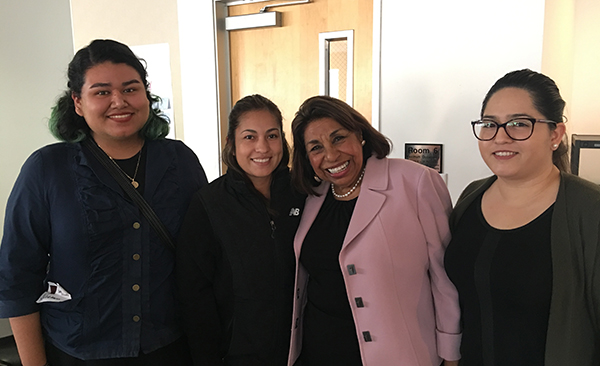 Sacramento State students Julieanna Flores (left), Kathy Martinez (center left) and Rebeca Orozco-Chavez (right) stand with civil rights activist Sylvia Mendez, who spoke to students and faculty during their visit to the Museum of Tolerance in Los Angeles. (Photo special to Sacramento State)
Sacramento State students Julieanna Flores (left), Kathy Martinez (center left) and Rebeca Orozco-Chavez (right) stand with civil rights activist Sylvia Mendez, who spoke to students and faculty during their visit to the Museum of Tolerance in Los Angeles. (Photo special to Sacramento State)When future educators come to Sacramento State to earn their credentials, they naturally expect to learn the essential skills for teaching K-12 students.
But in addition to math, science, language arts and other core topics, what about teaching social justice, diversity and inclusiveness?
To equip students with skills to address these important topics, faculty in the College of Education are working to incorporate what is known as the “Teaching Tolerance Curriculum,” a set of resources developed by the Southern Poverty Law Center to help teachers “create civil and inclusive school communities where children are respected, valued and welcome participants.”
The goal is to provide Sacramento State students the tools and know-how to create lesson plans focused on these topics and ensure that their classrooms promote inclusion and tolerance. That, in turn, provides a better learning experience for the diverse student population they will serve upon entering the profession.
“It’s our college mission to teach social justice in a multicultural setting, but if we keep that at the theoretical level without bringing it down to some practicality, we are less likely to see it go beyond our program,” said Lana Daly, a lecturer of education who, along with Professor of Education Maggie Beddow, has led the effort to incorporate the curriculum into Sacramento State’s multiple-subject credential program.
“We want our students to empower their own students, who are very diverse,” said Beddow. “There’s a lot of bullying going on. We want our students to learn how to use critical practices and tools in their classrooms that foster empathy and resilience in children while promoting academic improvement via anti-bias curriculum.”
The Teaching Tolerance Curriculum provides teaching credential students with a variety of resources such as texts, films, teaching strategies and lessons, and an online tool that allows them to build a lesson plan or unit. All are aligned with what creators call “Social Justice Standards,” teaching standards organized into four domains: identity, diversity, justice, and action.
The learning process starts in January, when multiple-subject credential students travel to the Museum of Tolerance in Los Angeles, through grant funding provided by the museum. There, they get the opportunity to hear speakers such as Holocaust survivors and civil rights icons talk about their experiences as survivors and social justice leaders. The students are then trained on the principles and use of the Teaching Tolerance Curriculum.
In 2014, Beddow and Daly participated in a Teaching Tolerance research study and led the first group of 14 multiple subject students to the Museum of Tolerance training. They have been taking students to the museum every year since, with 60 of the 78 students in the program making the trip this January, along with professors Sue Baker and Aaminah Norris.
Back on campus, foundational-level courses include projects and other assignments that ask students to use the resources to build lesson plans and incorporate them into their student teaching. For example, in Beddow’s social studies methods course, student teachers use the curriculum to create lessons about labor icons César Chávez and Dolores Huerta. Those lessons can have particular resonance with California students of color, especially those with migrant farmworker roots.
In thinking about these issues, Beddow and Daly say, Sacramento State’s student-teachers can become teachers whose classrooms are inclusive and responsive to the K-12 students’ diverse needs. That helps the K-12 students build confidence in their identity, improving their social and emotional wellbeing.
“It’s more than just delivering a curriculum unit,” Daly said. “It’s about how you make decisions on resources, instructional strategies, setting up your physical environment. 'Does my classroom seating arrangement allow for kids to have safe expression of identity, and learn from others who are diverse? Maybe not, so I’ll change my physical arrangement.' ”
The visit to the Museum of Tolerance was insightful and emotional, said multiple-subject credential student Corrine Delaney. It helped her realize the impact she can have in helping students understand events, as well as how she can introduce topics such as social justice and tolerance into her classrooms.
“I plan on using the resources that are found in Teaching Tolerance to show my students different perspectives on historical events,” Delaney said. “A lot of schools have their own curriculum, but it’s nice to bring in the resources they have on the website to show that there’s more than one perspective or more than one story from a historical event.”
Visit Sacramento State’s credentials programs web page for more information. – Jonathan Morales
